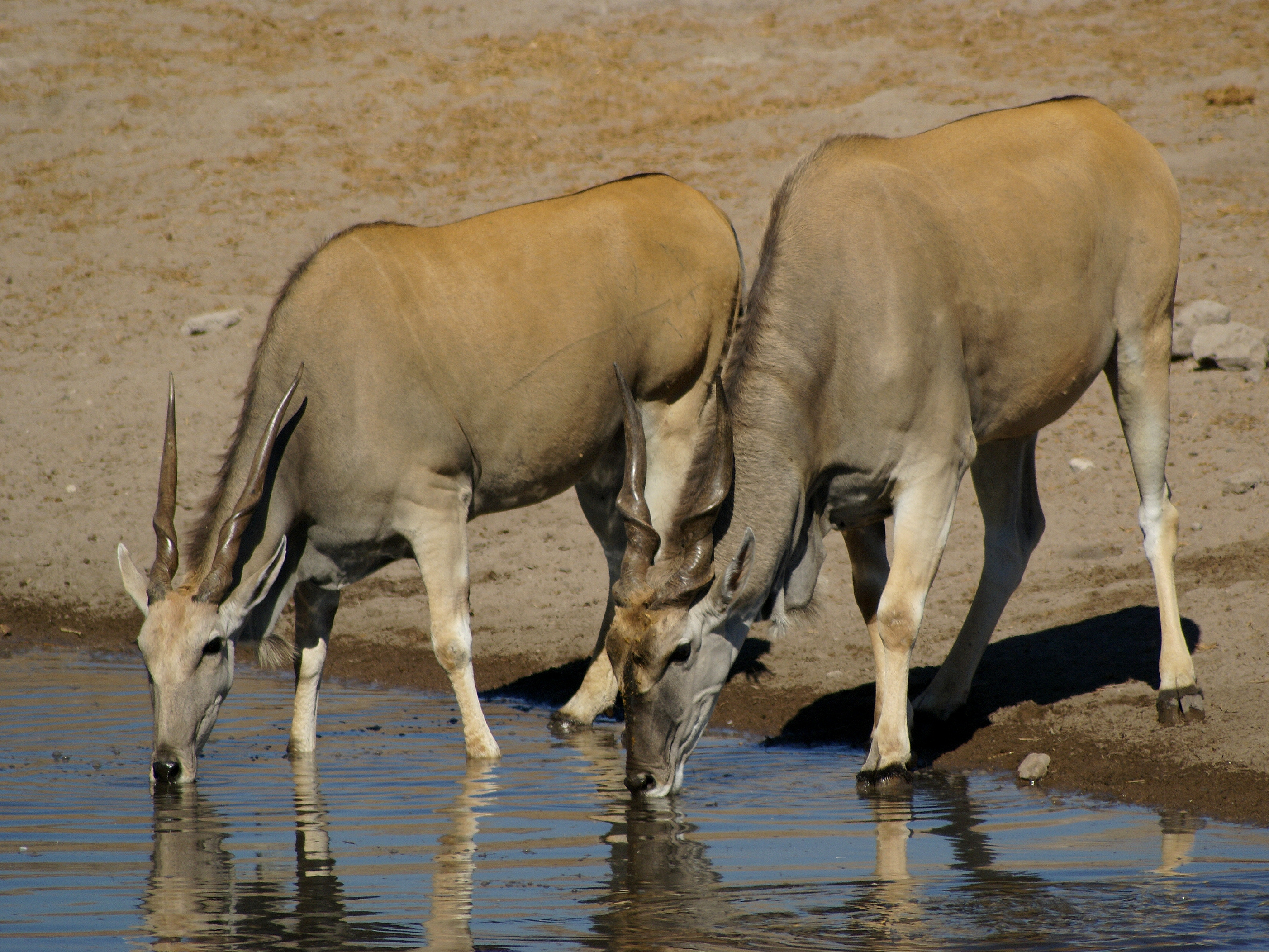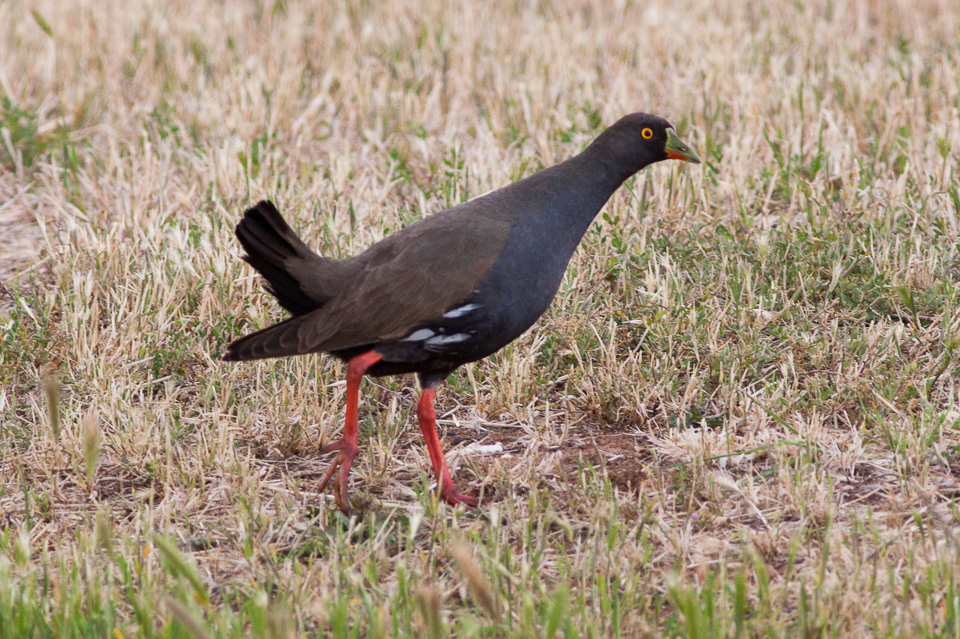|
Black-tailed Nativehen
The black-tailed nativehen (''Tribonyx ventralis'') is a rail native to Australia. Description The black-tailed nativehen is a large dark bird, reaching about 38 cm in length and weighing around . This species possesses an erect tail and is endowed almost entirely with brownish-grey and green feathers. Its long legs and lower jaw are a striking pink-orange colour, as well as its eyes which are more of a bright orange colour. This species is not excessively vocal, its main call is an alarm 'kak' sound. They become noticeable when they are seen in small flocks on the ground. Their erect tails and social behaviour are reminiscent of domestic hens. Habitat This species is nomadic, following seasonal water sources. It is found year-round living near fresh and brackish water. Distribution The black-tailed nativehen is common throughout Australia, where it lives by permanent as well as intermittent water sources. It has a large range, with an estimated global extent of occurrence ... [...More Info...] [...Related Items...] OR: [Wikipedia] [Google] [Baidu] |
John Gould
John Gould (; 14 September 1804 – 3 February 1881) was an English ornithologist who published monographs on birds, illustrated by plates produced by his wife, Elizabeth Gould (illustrator), Elizabeth Gould, and several other artists, including Edward Lear, Henry Constantine Richter, Joseph Wolf and William Matthew Hart. Because of his 1840s seven-volume series ''The Birds of Australia (Gould), The Birds of Australia'' and its updates he has been considered the father of bird study in Australia, and the Gould League in Australia is named after him. His identification of the birds now nicknamed "Darwin's finches" played a role in the inception of Darwin's theory of evolution by natural selection. Gould's work is referenced in Charles Darwin's book, ''On the Origin of Species''. Early life John Gould was born in Lyme Regis, the first son of a gardener. Both father and son probably had little education. After working on Dowager Lady Poulett's glass house, his father obtained ... [...More Info...] [...Related Items...] OR: [Wikipedia] [Google] [Baidu] |
Rallidae
Rails (avian family Rallidae) are a large, Cosmopolitan distribution, cosmopolitan family (biology), family of small- to medium-sized terrestrial and/or semi-amphibious birds. The family exhibits considerable diversity in its forms, and includes such ubiquitous species as the crakes, coots, and gallinule; other rail species are extremely rare or endangered. Many are associated with wetland habitats, some being semi-aquatic like waterfowl (such as the coot), but many more are wading birds or shorebirds. The ideal rail habitats are marsh areas, including rice paddy, rice paddies, and flooded fields or open forest. They are especially fond of dense vegetation for nesting.Horsfall & Robinson (2003): pp. 206–207 The rail family is found in every Terrestrial animal, terrestrial habitat with the exception of dry desert, Polar climate, polar or freezing regions, and Alpine climate, alpine areas (above the snow line). Members of Rallidae occur on every continent except Antarctica. N ... [...More Info...] [...Related Items...] OR: [Wikipedia] [Google] [Baidu] |
Australia
Australia, officially the Commonwealth of Australia, is a country comprising mainland Australia, the mainland of the Australia (continent), Australian continent, the island of Tasmania and list of islands of Australia, numerous smaller islands. It has a total area of , making it the list of countries and dependencies by area, sixth-largest country in the world and the largest in Oceania. Australia is the world's flattest and driest inhabited continent. It is a megadiverse countries, megadiverse country, and its size gives it a wide variety of landscapes and Climate of Australia, climates including deserts of Australia, deserts in the Outback, interior and forests of Australia, tropical rainforests along the Eastern states of Australia, coast. The ancestors of Aboriginal Australians began arriving from south-east Asia 50,000 to 65,000 years ago, during the Last Glacial Period, last glacial period. By the time of British settlement, Aboriginal Australians spoke 250 distinct l ... [...More Info...] [...Related Items...] OR: [Wikipedia] [Google] [Baidu] |
Extent Of Occurrence
Extent may refer to: Computing * Extent (file systems), a contiguous region of computer storage medium reserved for a file * Extent File System, a discontinued file system implementation named after the contiguous region * Extent, a chunk of storage space logical volume management uses internally to provide various device mappings * Extent, in computer programming, is the period during which a variable has a particular value Other * Extent, a technical description of the wingspan of a bird, bat, or other flying animal * Extent, a writ allowing a creditor to seize or assume temporary ownership of a debtor's property; also, the actual seizure in its execution * Map extent A map extent is the portion of area of a region shown in a map. The limits of a map extent are defined in the coordinate system of the map. In Western culture, map extents usually have a rectangular shape, so they are defined with a minimum and ..., the portion of a region shown in a map See also * Ex ... [...More Info...] [...Related Items...] OR: [Wikipedia] [Google] [Baidu] |
Least Concern
A least-concern species is a species that has been evaluated and categorized by the International Union for Conservation of Nature (IUCN) as not being a focus of wildlife conservation because the specific species is still plentiful in the wild. They do not qualify as threatened, near threatened, or (before 2001) conservation dependent. Species cannot be assigned the "Least Concern" category unless they have had their population status evaluated. That is, adequate information is needed to make a direct, or indirect, assessment of its risk of extinction based on its distribution or population status. Evaluation Since 2001 the category has had the abbreviation "LC", following the IUCN 2001 Categories & Criteria (version 3.1). Before 2001 "least concern" was a subcategory of the " Lower Risk" category and assigned the code "LR/lc" or lc. Around 20% of least concern taxa (3261 of 15,636) in the IUCN database still use the code "LR/lc", which indicates they have not been re- ... [...More Info...] [...Related Items...] OR: [Wikipedia] [Google] [Baidu] |
IUCN
The International Union for Conservation of Nature (IUCN) is an international organization working in the field of nature conservation and sustainable use of natural resources. Founded in 1948, IUCN has become the global authority on the status of the natural world and the measures needed to safeguard it. It is involved in data gathering and Data analysis, analysis, research, field projects, advocacy, and education. IUCN's mission is to "influence, encourage and assist societies throughout the world to conserve nature and to ensure that any use of natural resources is equitable and ecologically sustainable". Over the past decades, IUCN has widened its focus beyond conservation ecology and now incorporates issues related to sustainable development in its projects. IUCN does not itself aim to mobilize the public in support of nature conservation. It tries to influence the actions of governments, business and other stakeholders by providing information and advice and through buildin ... [...More Info...] [...Related Items...] OR: [Wikipedia] [Google] [Baidu] |
Tribonyx
''Tribonyx'' is a small genus of birds in the Rail (bird), rail family, containing two extant species and one Holocene extinction, recently extinct species. The genus is endemism, endemic to Australia and New Zealand. They are sometimes lumpers and splitters, lumped with the moorhens in ''Gallinula''. Species The living and recently Extinction, extinct species are: References Tribonyx, Bird genera Rallidae Birds of Australia Taxa named by Bernard du Bus de Gisignies {{Gruiformes-stub ... [...More Info...] [...Related Items...] OR: [Wikipedia] [Google] [Baidu] |
Endemic Birds Of Australia
This article is one of a series providing information about endemic (ecology), endemism among birds in the world's various zoogeographic zones. For an overview of this subject see Endemism in birds. Patterns of endemism Family-level endemism is prominent in Australia. The Australasian realm, Australasian biogeographic region has the highest number of endemic family (biology), families of any zoogeographic region except the Neotropics, and many of these families are endemic to Australia itself — the country therefore stakes a strong claim to be the world's greatest hotspot of bird endemism. Australian endemic and near-endemic families The Australian endemic families are: * Emu (Dromaiidae), a well-known monotypic family; the emu is found in rural areas throughout the continent * Plains-wanderer (Pedionomidae), a monotypic family; plains-wanderer is restricted to arid inland areas in the southeast of Australia * Lyrebirds (Menuridae), two forest-dwelling species of southea ... [...More Info...] [...Related Items...] OR: [Wikipedia] [Google] [Baidu] |
Birds Described In 1837
Birds are a group of warm-blooded vertebrates constituting the class (biology), class Aves (), characterised by feathers, toothless beaked jaws, the Oviparity, laying of Eggshell, hard-shelled eggs, a high Metabolism, metabolic rate, a four-chambered heart, and a strong yet lightweight Bird skeleton, skeleton. Birds live worldwide and range in size from the bee hummingbird to the common ostrich. There are over 11,000 living species and they are split into 44 Order (biology), orders. More than half are passerine or "perching" birds. Birds have Bird wing, wings whose development varies according to species; the only known groups without wings are the extinct moa and elephant birds. Wings, which are modified forelimbs, gave birds the ability to fly, although further evolution has led to the Flightless bird, loss of flight in some birds, including ratites, penguins, and diverse endemism, endemic island species. The digestive and respiratory systems of birds are also uniquely a ... [...More Info...] [...Related Items...] OR: [Wikipedia] [Google] [Baidu] |





